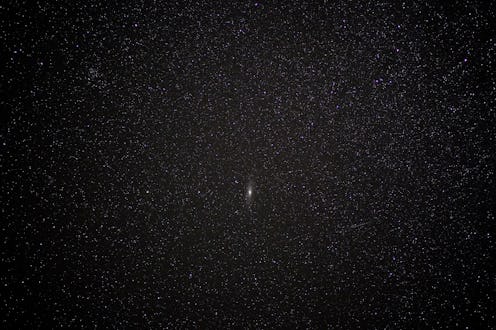Life
Two Black Holes Could Collide In A Neighboring Galaxy
Consider this your biannual reminder that we're all specks of dust floating around an indifferent universe filled with natural wonders, and sometimes, those wonders join forces to create something straight out of a science fiction movie. I'm talking about supermassive black holes, which take an already-terrifying phenomenon and turn the dial up so high it snaps off. Unfortunately for my peace of mind (and probably yours in a few minutes), astronomers have recently discovered evidence that in a neighboring galaxy, two supermassive black holes are lurking right beside one another — so close to each other that they're likely to merge one day.
According to Astronomy magazine, the galaxy in question is Cygnus A, an elliptical galaxy located a little less than 800 million light-years away from Earth. That's about 300 times further away than the nearby Andromeda galaxy, so it's not terribly close. However, thanks to the massive amounts of energy put forth by the supermassive black hole at the center of the galaxy, Cygnus A appears as one of the brightest radio sources in the sky. You'd think that one monster black hole would be enough for a single galaxy, but that doesn't appear to be the case. On Tuesday, radio astronomers announced a "prominent new feature" within 1,500 light-years of the known black hole.
Here's the unnerving bit: Researchers believe the object is another supermassive black hole.
Astronomers used the National Science Foundation's Very Large Array (VLA) telescope to identify the extremely bright object. In a press release, they identified two possibilities. The first is an exploded supernova, but the object's brightness has been too consistent over time to fit the profile of any known supernovas. The second, and most likely, is that the object is an outburst from a supermassive black hole near the center of Cygnus A. According to astronomers, the object shares many characteristics with a black hole devouring its surrounding matter. In fact, this could be why the VLA was finally able to spot the black hole — it might have found something new to feed on, making it more active.
"We think we’ve found a second supermassive black hole in this galaxy, indicating that it has merged with another galaxy in the astronomically-recent past,” said astronomer Chris Carilli in a press release. “These two would be one of the closest pairs of supermassive black holes ever discovered, likely themselves to merge in the future." That means exactly what you think it means. The two black holes are likely to blend into a single, bigger black hole.
So what is a supermassive black hole? Basically, it's a regular black hole on steroids. According to NASA, black holes are areas of space where the gravitational pull is so strong even light isn't fast enough to escape. Despite the name, they're actually invisible to the human eye. Without light, after all, you can't see anything. Black holes have such strong gravity because a large amount of matter has been squeezed into a comparatively small amount of space; usually, they're formed by the collapse of a star.
As you can probably figure out from the name, supermassive black holes have a far greater mass than a typical black hole — one million to one billion times more, to be more precise. It took years for astronomers to find direct evidence that they exist, but it's been determined that they lie at the center of every large galaxy. Astronomers are still trying to explain how supermassive black holes form. Some say they're ancient black holes that have consumed immense amounts of matter; others claim they form when mid-sized black holes created by a cluster of collapsed stars merge together. Basically, the jury is still out on this one.
Supermassive black holes might sound scary, but the Cygnus A discovery isn't anything to worry about. The galaxy may be bright, but it's not exactly our close neighbor. Besides, supermassive black holes are all over the universe. There's even one in the Milky Way: Sagittarius A. So there's no need to panic, but it is something to remember next time you're annoyed because your Instagram post only got nine likes. Astronomy has a way of putting things in perspective.
